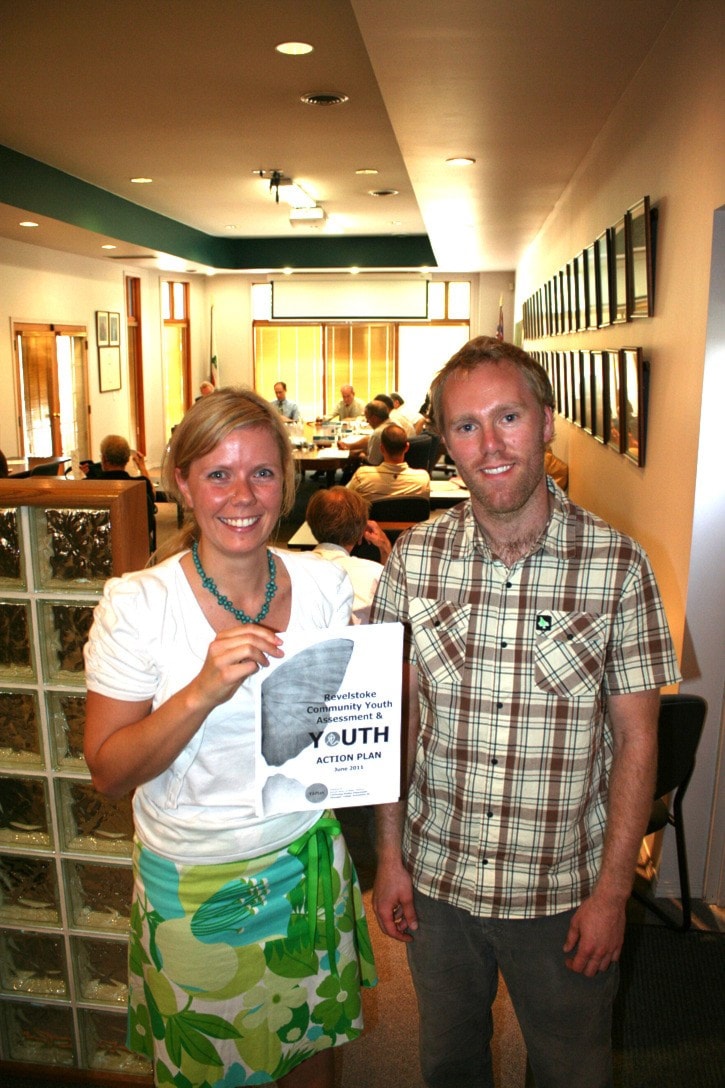A new Revelstoke Youth Action Plan was released for public viewing last week. The 62-page document surveys the state of youth and youth services in Revelstoke and provides recommendations on ways the community can better engage youth with programming, facilities and other services.
Okanagan College Youth Program Liaison Mike Brown and Okanagan Youth Skills Link program assistant Megan Shandro presented preliminary findings to Revelstoke city council on June 21, a couple of weeks before the final plan became available online.
They told council the plan was based on a survey of youth conducted by them this year. Okanagan College was the lead agency on the federally-funded study. The study and plan was overseen by the Revelstoke Youth Initiative Committee, which consists of nearly 30 key representatives from groups including the City of Revelstoke, local education organizations, health organizations and more.
Shandro and Brown broke the survey down into key findings for council.
Employment, education and training
Employment is hard to get for youth, especially for women, younger youth and those who are newer to town. “A relationship was also noted between individuals who had difficulty finding work and a likelihood of espousing a negative view of the community, tourists, and temporary workers,” they write in a summary.
The report notes there is more desire for local post-secondary education, but a lack of student numbers makes it difficult to provide the programming.
The study also found that 35 per cent of youth with college diplomas or higher were underemployed.
The Youth Action Plan outlines key objectives to improve the situation. They include providing youth with opportunities to explore education options, providing more advanced education and training, providing public study spaces and supporting job creation projects that provide skills development opportunities.
Entertainment, Recreation and Culture
Revelstoke is a great place for outdoor fun, but youth face barriers accessing some activities. 62 per cent said money was a barrier, while others also noted equipment, training and knowledge was holding them back.
Key initiatives youth supported include a new skatepark and pump-track as well as expanded bike trails and longer pool hours. An off-leash dog park was another suggestion.
Youth also had difficulty finding information on organized activities for them in town.
The plan outlines several objectives to change the situation. They include fostering the creation of low cost, community-based programs, identifying and enhancing youth-friendly community spaces and using local landscapes to their fullest potential.
Housing, Health and Community Safety
One key finding was youth had some difficulty accessing health services. Less than half of respondents who experienced mental health issues even tried to access services, while significant percentages of others who tried to get help weren’t successful.
“Asked why they did not access services, some respondents commented they did not know where to go, were concerned about confidentiality, and could not access transportation,” the preliminary report notes.
The plan outlines several goals to improve the situation. They include making youth more aware of services, ensuring housing options are accessible to youth, and ensuring harm reduction and basic needs are met.
Citizenship, Engagement and Connectivity
Revelstoke got the nod as a welcoming place. 89 per cent felt it was welcoming, while 87 per cent felt a sense of belonging.
Membership in groups, clubs and organizations was highly skewed towards sports groups. 65 per cent belonged to a sports club, while only 12 per cent were involved in arts groups, 13 per cent in community service, four per cent in cultural groups and only two per cent in political ones. “There’s no so much happening [for youth] with arts and culture,” Shandro told council.
The plan’s objectives to improve the community in these categories include creating a youth coordinator position in Revelstoke, engaging youth in decision-making and supporting youth-driven initiatives. Other ideas include creating a centralized place to find and share information and showcasing youth talent and accomplishments.
What happens next?
Having the plan in place is a key step towards accessing further funding. The authors hope one of the outcomes will be the creation of a youth coordinator position. “The original goal was to fill a gap in planning,” Brown told the Times Review in an interview. “The coordinator position is something that has come out of it, a little bit unexpectedly,” he said.
Brown and Shandro said their hope is this newly created coordinator position would be independent from direct control by any one organization. The coordinator would coordinate with a range of existing services. Brown told the Times Review they hoped the coordinator could be based out of the new Neighbourhoods of Learning centre planned for the new Revelstoke high school. “We’re hoping that this position is not something that’s associated with one organization,” Shandro told council.
Brown said the main focus of the role would be to coordinate services. “This type of planning allows you to avoid redundancies,” he said.
